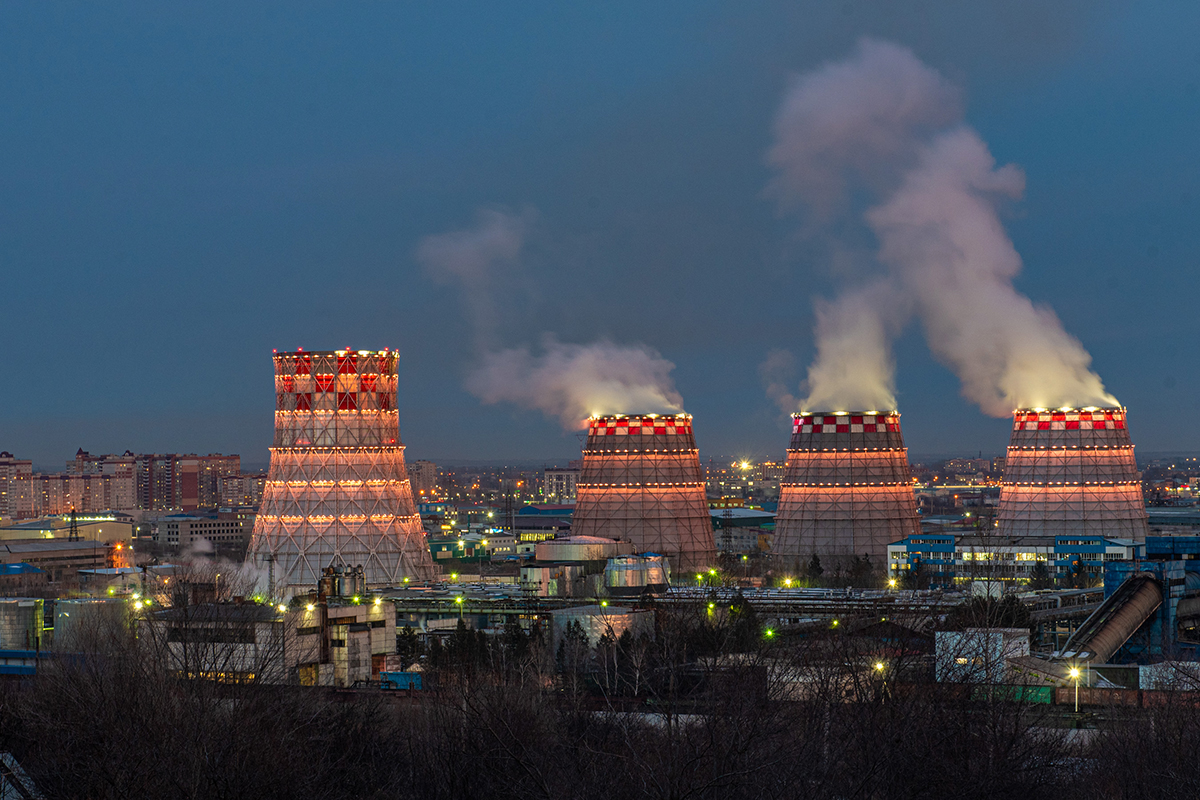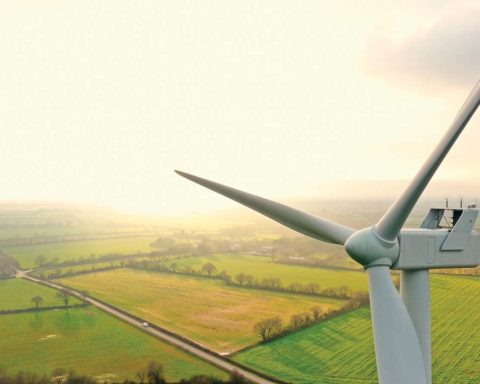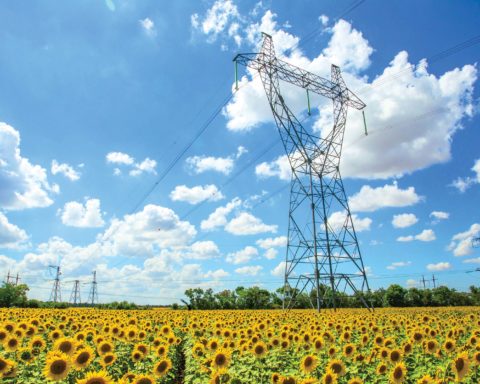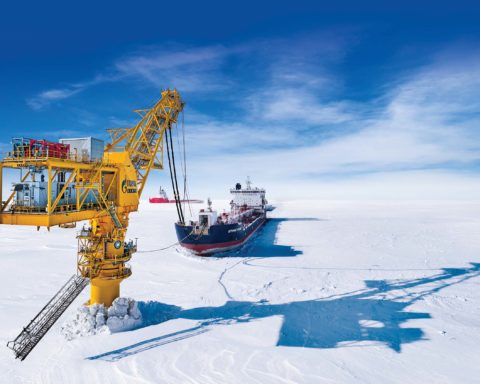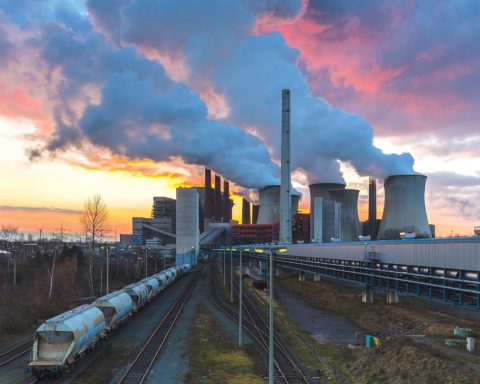Anatoly LAGEREV
Senior Researcher of the Melentiev Energy Systems
Institute, Siberian Branch of the Russian Academy of
Sciences, PhD in Engineering
e-mail: lagerev@isem.irk.ru
Valentina KHANAEVA
Senior Researcher of the Melentiev Energy Systems
Institute, Siberian Branch of the Russian Academy of
Sciences, PhD in Economics
e-mail: hanaeva@isem.irk.ru
Introduction
Forecasts of country and regional scenarios of greenhouse gas emissions show that significant changes in the dynamics and levels of greenhouse gas emissions are possible only under the condition of significant technological changes in the production, transformation and consumption of various types of fuel and energy resources. Almost all studies related to limiting СО2 emissions make a significant contribution to the electric power industry. It currently accounts for about a third of the country’s greenhouse gas emissions.
Herewith, it is the electric power industry that has the greatest (among other sectors of the economy) technological capabilities for the implementation of target restrictions on greenhouse gas emissions.
Methodical approach
The methodological approach for assessing the impact of restrictions on greenhouse gas emissions on the innovative development of TPPs is based on the dynamic optimization model of the country’s FEC developed at the Melentiev Energy Systems Institute Siberian Branch of the RAS [1,2].
The proposed model makes it possible to consider the territorial and technological structure of production and consumption of primary energy resources, electricity, centralized heat, boiler and furnace fuel. It includes blocks: environmental, financial and economic and foreign trade.
The territorial aspect of the model describes the country’s FEC in the context of 7 regions, of which: two regions (the European part, the Urals) represent European Russia and five regions: Tyumen region (including Khanty-Mansi and Yamalo-Nenets Autonomous Okrug), the south of Western Siberia, Eastern Siberia, the Far East – Asian Russia.
The model is an optimization model: the coefficients of the functional are self-financing prices that ensure the self-sufficiency of energy facilities.
As the main optimization criterion, the model considers the minimum of the total discounted costs (for production, processing (transformation), transport, reduction of harmful emissions) for the entire calculation period with the maximum proceeds from the export of energy resources.
Below is a brief description of the block of electric and heat power engineering in the FEC model. Optimization of the prospective development of electricity and heat supply and the conditions for fuel supply to power plants and boiler houses involves the solution of the following tasks related to determining:
1) rational combination of the capacity of power plants of various types (HPP, NPP, CPP, CHPP) by regions of the country;
2) rational structure of electricity generation by types of power plants and types of fuel;
3) rational levels of district heating in the regions and in the country as a whole;
4) composition and required capacity of new equipment for power plants and boiler houses in the regions;
5) main transmissions of electricity between regions;
6) type of fuel and determination of its annual consumption by power plants and boiler houses by regions of the country
For this, several groups of equations are recorded for each region.
The first group of equations describes the annual electricity balance, which is formed from: a) electricity generation at own power plants operating on different types of fuel and equipment; b) receiving electricity from neighbouring regions; c) power flows to neighbouring regions; and d) the region’s annual electricity demand.
The second group of equations forms the annual heat balance in the region. For this, for each region, the following differentiation of heat sources is provided: CHPP on organic and nuclear fuel, large and small boiler houses, heat sources from secondary energy resources and non-traditional energy. Herewith, the level of district heating (heat supply from CHPPs) in the region is determined not only by the conditions for ensuring the balance of heat, but also by the conditions of their fuel supply, as well as by the participation of CHPPs in covering the electrical load of the corresponding region.
The third group of equations makes it possible to determine the type of fuel and its annual consumption for all sources of electricity and heat based on fossil fuel.
In each region, several options are being considered for the construction of power plants (using different technologies, for different types of fuel). In the optimization process, those options are selected that lead to a minimum of costs for the production of electricity and heat (for CHPP) in the region (considering the fuel prices and the fuel consumption at power plants).
In this case, the selection of the optimum (rational) option for the construction of a power plant will depend on: specific capital investments for the construction of power plants; specific fuel consumption for electricity generation and heat supply (power plants’ ER values); fuel prices; operating costs.
The fourth group of equations describes various technical constraints: for the installed capacity of existing and some new types of power plants, for heat supply from operating CHPPs, for main electricity flows, for fuel consumption for individual power plants or their groups, etc.
The model makes it possible to estimate (by country and selected regions): balances of primary energy resources; balances of boiler and furnace fuel (by type of fuel: gas, fuel oil, coal, other types of fuel); balances of electricity and district heating; promising technological structure of production in the FEC; interregional supplies of fuel (gas, coal, fuel oil) and electricity; the comparative efficiency and scale of foreign energy trade; greenhouse gas emissions and a set of measures to reduce them; required investments for the development of the FEC by industry.
Research results
Below are the results of assessing the impact of restrictions on СО2 emissions on the innovative development of TPPs in the regions of Russia in the long term.
Two options for greenhouse gas (СО2) emissions were considered: option 1 – without restrictions on greenhouse gas emissions; option 2 – with restrictions on greenhouse gas emissions from fossil-fuelled TPPs.
Herewith, it was assumed that greenhouse gas emissions (CO2) from fuel combustion at the country’s TPPs by 2050 in option 2 would not exceed 55% (450 mln t) of the level of emissions from thermal power plants in 1990 (835 mln t).
Three innovative technologies for generating electricity at TPPs using natural gas and coal were considered (Table 1):
–– combined-cycle gas plants (gas-fired TPP-CCGT);
–– coal-fired steam turbines designed for ultra-supercritical steam parameters (TPP-USCSP STU) without and with СО2 capturing;
–– integrated gasification combined cycle plants (TPP-IGCC) without and with СО2 capturing.
The use of capture systems at power plants will reduce СО2 emissions by 75–90%, but will lead to a 1.5–2-fold increase in capital investments and a 7-8% decrease in plant ER.
As traditional technologies, the following were considered: for coal-fired CPPs – steam turbine plants for supercritical steam parameters, for CHPPs – modernized steam turbine and gas turbine plants.
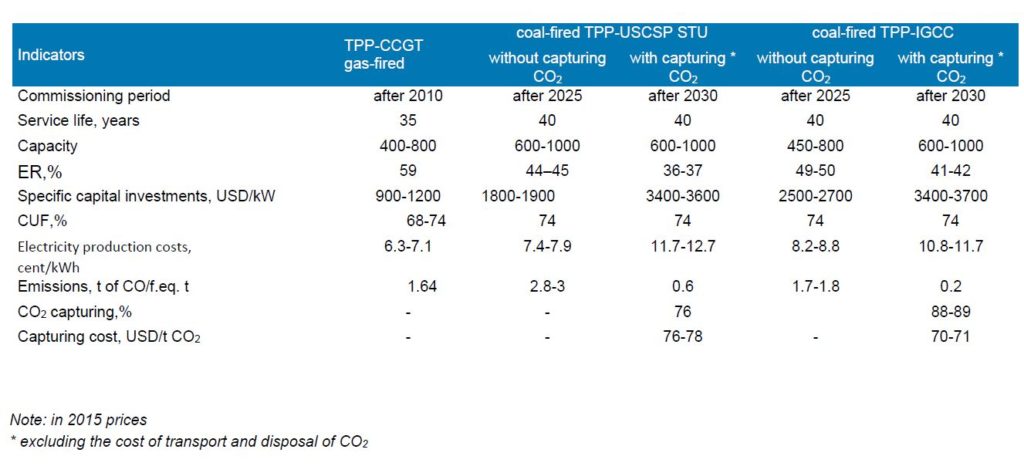
Sources: of innovative technologies at TPPs in Russia [6–8] and the authors’ calculations
The studies were performed for the optimistic scenario of the country’s economic development (Table 2). Pursuant to the accepted scenario, the average annual GDP growth rate in the period 2020–2030 will amount to 3.6%, and 3.3% in the period 2031–2040. It is predicted that in the coming years the GDP growth rate will slow down to 2.9%.

and energy consumption in Russia (in 2015 prices)
Sources: [3-5] and authors’ estimates
In the considered scenario of the country’s economic development, electricity production for the period under consideration (2020–2050) should increase by about 1.7 times. Herewith, 35% of the increase in electricity production in the country will be provided by carbon-free sources of electricity (NPP, HPP, RES) and 65% by TPP using fossil fuels (Table 3).

Note: in the table, the left border of the range of values corresponds to option 1 – without restrictions on greenhouse gas emissions; right – option 2 – with restrictions on greenhouse gas emissions from TPPs
Taking into account the projected levels of electricity consumption, the volume of electricity exports and the technologically necessary dismantling of obsolete equipment, the commissioning of generating capacities at Russian power plants is projected at 57-59 mln kW by 2030, 145-164 mln kW by 2040 and 212-241 mln kW by 2050 (table 4).
Herewith, by 2050, it is planned to commission 39 mln kW of capacities at NPPs, 14 mln kW at HPPs (PSPPs), 13.5 mln kW at RESs and 146-175 mln kW at TPPs. In addition, it is expected that by the end of the period 121 mln kW of physically worn out and obsolete equipment at TPPs and 20–21 mln kW at NPPs will be decommissioned [9,10].
As a result, the installed capacity of Russian power plants should increase by 2050 (compared to 2020) by 32–39% and reach 332–348 mln kWh. The dynamics of changes in the installed capacity of Russian power plants is shown in Table 4.
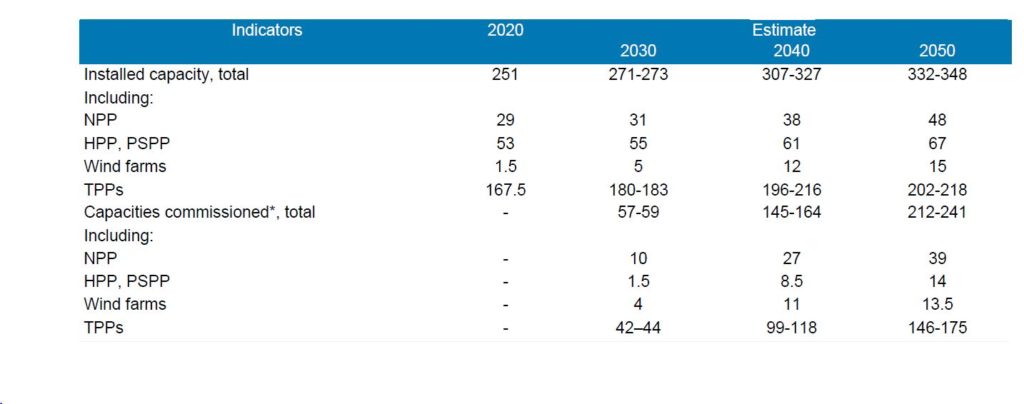
*cumulative total relative to 2020
The studies show that even with the projected (increased) scale of development of NPPs (48 GW by 2050), HPPs, PSPPs (67 GW) and RESs (15 GW), by 2050, the task of limiting greenhouse gas emissions (СО2) from fuel combustion at TPPs (50% lower than in 1990) is possible only through the employment of the innovative technologies at thermal power plants.
Studies have shown that in the European part of the country this can be done through the large-scale deployment of the gas-fired TPP-CCGT units (93 mln kW by 2050) and the innovative coal-fired technologies with coal gasification and СО2 capturing (23 mln kW by 2050) – table 5.
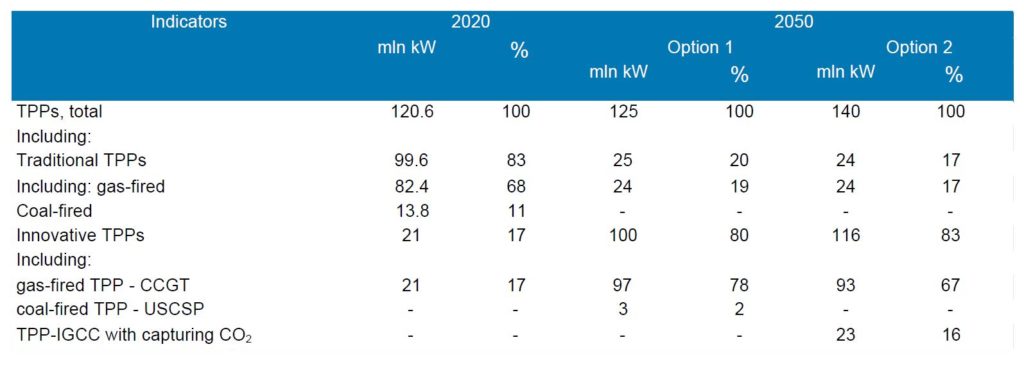
In the Asian part of Russia, limitation of emissions from fuel combustion at TPPs by 2050 will require the deployment of 35 mln kW gas-fired TPP-CCGT units, 33 mln kW TPP-CCGT units with coal gasification and CO2 capturing and 3 mln kW of the coal-fired steam turbine TPP-USCSP units with installations designed for the ultra supercritical steam parameters (table 6).
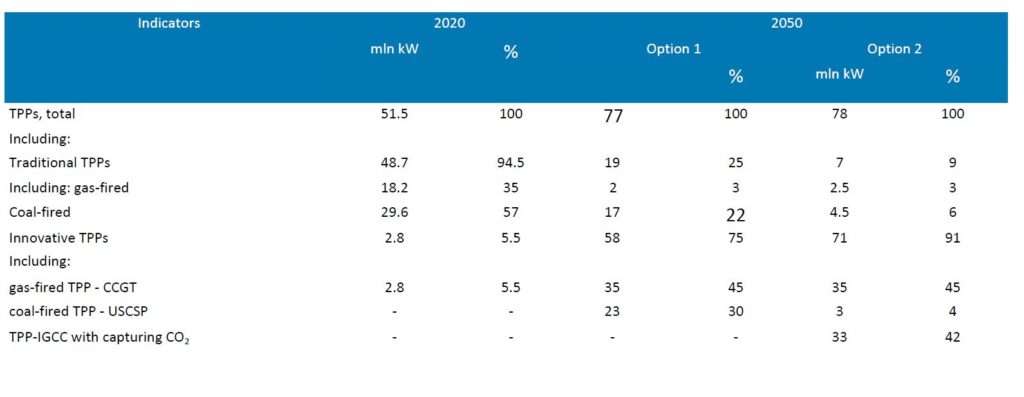
The dynamics of changes in the volumes of consumption of boiler and furnace fuel (BFF) at power plants in Russia is shown in Table 7.
The current structure of fuel consumption at power plants in the European part of the country has a gas orientation. The share of gas in the structure of fuel burned by power plants in 2020 was about 82%, the share of coal – 17%. The share of fuel oil accounted for less than 1%.
As follows from Table 7, in option 2, compared to option 1, the consumption of the BFF at TPPs in the European part in 2050 should decrease by 6-7% (by 13 f.eq. mln t), while the gas consumption will decrease by 17% by 31 f.eq. mln t), and the consumption of coal will increase 2.2 times (by 18 f.eq. mln t).
In 2020, in the structure of fuel burned at power plants in the Asian part of Russia, gas accounted for 43%, coal for 56%, and fuel oil for less than 1%.
By 2050, in option 2, compared to option 1, the consumption of the BFF at TPPs in the Asian part should decrease by 5% (7 f.eq. mln t), while the demand for gas will decrease by 5–6 f.eq. mln t, as well as the demand for coal – by 2 f.eq. mln t.
In general, the consumption of the BFF at TPPs in Russia in option 2 compared to option 1 in 2050 will decrease by 20 f.eq. mln t.
The projected volumes of СО2 emissions from fuel combustion at TPPs by regions of Russia are shown in Table 8.
Studies have shown that the volume of CO2 emissions from TPPs in European regions of Russia (in option 2 compared to option 1) should be reduced by 2050
In the Asian part of Russia, limitation of emissions from fuel combustion at TPPs by 2050 will require the deployment of 35 mln kW gas-fired TPP-CCGT units, 33 mln kW TPP-CCGT units with coal gasification and CO2 capturing and 3 mln kW of the coal-fired steam turbine TPP-USCSP units with installations designed for the ultra supercritical steam parameters (table 6).
The dynamics of changes in the volumes of consumption of boiler and furnace fuel (BFF) at power plants in Russia is shown in Table 7.
The current structure of fuel consumption at power plants in the European part of the country has a gas orientation. The share of gas in the structure of fuel burned by power plants in 2020 was about 82%, the share of coal – 17%. The share of fuel oil accounted for less than 1%.
As follows from Table 7, in option 2, compared to option 1, the consumption of the BFF at TPPs in the European part in 2050 should decrease by 6-7% (by 13 f.eq. mln t), while the gas consumption will decrease by 17%
by 13-14% and amount to 268 mln, i.e. 60% of the total emissions in the country.


Herewith, in the Asian part (Siberia and the Far East), the greenhouse gas emissions at TPPs by 2050 in option 2 compared to option 1 will be reduced by 43% and will amount to 182 mln t or 40% of the total country’s emissions. Approximately 36% (162 mln t) of emissions will come from Siberia, 4% (20 mln t) – from the Far East.
Table 9 shows the required investments for the construction of power plants by regions of Russia.

Studies have shown that changes in the structure of generating capacities caused by restrictions on CO2 emissions will lead to additional investments in more expensive projects. If in option 1 the total investment in power plants in the period 2021–2050 will amount to 773 bln USD, then with the considered restrictions on СО2 emissions option 2), the increase in capital investments is estimated additionally at 300 bln USD. It follows from this that more than 16 bln USD will be required to reduce emissions in option 2 relative to option 1 by 10 mln t of СО2.
Conclusion
- The proposed methodological approach for assessing the impact of restrictions on greenhouse gas emissions on the innovative development of TPPs is based on the dynamic optimization model developed in the Melentiev Energy Systems Institute Siberian Branch of the RAS as a tool for studying the FEC of the country and regions.
- One of the possible ways to reduce the dependence of Russia’s electricity supply on the increase in greenhouse gas emissions in the country is the timely development and implementation of fossil fuel TPPs using innovative technologies.
- The studies indicate that even with an increased scale of development of NPPs, HPPs, RESs, by 2050, the task of limiting the greenhouse gas emissions (CO2) from fuel combustion at TPPs by 50% lower than the 1990 level can only be achieved through the innovative technologies.
Herewith, if in the European part this is possible mainly due to the large-scale employment (in the period under consideration) of a gas-fired CCGT units and the coal-fired TPP-CCGT units with coal gasification and CO2 capturing, in Siberia and the Far East – due to the employment of the gas-fired TPP-CCGT units, the TPP-CCGT with coal gasification and CO2 capture and the steam turbine TPPs with units for ultra supercritical steam parameters (TPP-USCSP). - The projected introduction of new innovative technologies at TPPs will allow by 2050 (compared to 2020) to reduce the average specific fuel consumption for electricity production in the European part of the country by 17-18%, in the Asian part – by 19-20%.
- Studies have shown that changes in the innovative and technological structure of fossil fuel thermal power plants caused by restrictions on greenhouse gas emissions will require significant investment in their construction.
The research was performed within the framework of the state assignment project (No. FWEU-2021-0006) of the fundamental research program of the Russian Federation for 2021-2030.

